 Image search results - "omi" Image search results - "omi" |

Hino was home to many Omi merchants who plied up and down Japan during the Edo Period to sell and trade their wares. They became quite successful selling medicines, lacquerware, sake, etc. Those from Hino were called Hino shonin (Hino merchants).
|
|
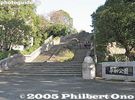
Entrance to the Peace Park
|
|

Barrels of Hino merchant sake
|
|

Peace Fountain with the Peace Statue in the distanceA fountain of water was made for the victims who were desperate for water.
|
|
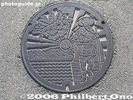
Manhole with the symbol of Hino merchant, Shiga Prefecture
|
|
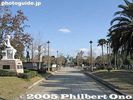
Path to Peace Statue
|
|

Omi Hino Merchant House. The former home of Hino merchant Yamanaka Hyouemon was donated to the town in 1981. Now a museum exhibiting the history and artifacts of the Hino merchants. 近江日野商人館Small admission charged. Open 9 am to 4 pm, closed on Mon. and Fri. Close to the center of town.
Address: Okubo 1011, Hino-cho
Phone No.: 0748-52-0007
山中兵右衛門
|
|
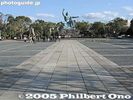
Peace StatueEvery Aug. 9, the anniversary of the atomic bombing, a memorial service is held here.
|
|
|
|
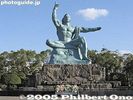
Peace StatueSculptor was Seibo Kitamura.
|
|

Inside Omi Hino Merchant House近江日野商人館
|
|

The Peace Statue was built in Aug. 1955, the 10th anniversary of the bombing. The Peace Statue was modeled after popular wrestler Rikidozan.
|
|

Lacquerware sold by Hino merchants近江日野商人館
|
|

The folded right leg symbolizes quiet meditation.
|
|

Inside Omi Hino Merchant House
|
|

The right hand points to the threat of nuclear weapons.The bronze statue is 10 meters tall.
|
|

Inside Omi Hino Merchant House
|
|

Omi Fair video taken on March 2, 2014 at Takashimaya Dept. Store in Nihonbashi, Tokyo. Funazushi, Omi beef, Biwa pearls, and more. We also saw Hiko-nyan.
|
|

The closed eyes express a prayer for all war victims.
|
|

At 271 meters high, Mt.Hachiman-yama was the site of Hachiman Castle built by Toyotomi Hidetsugu in 1585. Now home to Zuiryuji temple of the Nichiren Sect, some of the castle's stone walls still remain. MAP
|
|

The 31st temple on the Saigoku (Western Japan) Pilgrimage circuit, Chomeiji (Long Life Temple) worships the Kannon goddess dedicated to long life and good health. It belongs to the Tendai Buddhist sect. This sign points the way.Accessible by bus from Omi-Hachiman Station.
|
|

Musa-juku was the sixty-sixth of the sixty-nine stations or shukuba post towns on the Nakasendo Road. It is the seventh Nakasendo station in Shiga (following Echigawa-juku in Aisho). MAPMusa was one of ten Nakasendo stations in Shiga. There is very little left. Near Ohmi Railways Musa Station, a short ride from Omi-Hachiman.
|
|

Boat for Taketomi at Ishigaki Port.
|
|

Inside Omi Hino Merchant House
|
|

Itoh Chube'e Memorial House (Itoh Chube'e Ki'nenkan). Itoh Chube'e (1842-1903) was the founder of Itochu Corporation and Marubeni, two of Japan's largest trading companies, in 1858. MAPThis house displays his former residence and some of his possessions. A short walk from Toyosato Station, the house is open to the public on Tue., Thu., and Sat. Free admission.
|
|

From the Ohmi Railways' Gokasho Station, you can walk to the Fujii Hikoshiro House (藤井 彦四郎邸), which is also a history museum, and to the modern Ohmi Merchant Museum (近江商人博物館).Ohmi Railways Gokasho Station 近江鉄道五箇所駅
|
|

Gokasho is famous for the grand, old homes of wealthy Omi merchants. Three of them are clustered together for us to visit inside. They are the former residences of Tonomura Uhee (外村 宇兵衛), Tonomura Shigeru (外村 繁), and Nakae Jungoro (中江
|
|

Way to Takashimaya Dept. Store in Nihonbashi subway station.
|
|

During July-Aug. 2007, I helped to make the Yokaichi giant kite at the annex of the Yokaichi Giant Kite Museum.where the giant kite is made. Every three years, the giant kite, flown every May in Higashi-Omi, is replaced by a new kite bearing a new design.The new kite was made during July-Aug. 2007, taking about 30 days. The kite is made by volunteers from the public under the instruction of the Yokaichi Giant Kite Preservation Society. For the first time, I helped make this giant kite which was first flown successsfully on May 25, 2008 at the annual kite festival.
|
|
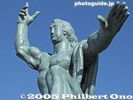
The outstretched left hand symbolizes tranquility and world peace.
|
|

On Taketomi, the best way to get around.
|
|

Inside Omi Hino Merchant House
|
|

Entrance to Itoh Chube'e Memorial House
|
|

You can buy a set of tickets to all four Omi merchant homes and the museum which cheaper than buying a ticket at each place. Ohmi Railways Gokasho Station 近江鉄道五箇所駅
|
|

Gokasho was home to many Omi merchants who plied up and down Japan during the Edo Period to sell and trade their wares. They became quite successful selling medicines, lacquerware, sake, etc.Wall of former home of Omi merchant Tonomura Shigeru (1902-1961) (外村 繁邸).
|
|

Way to Takashimaya Dept. Store in Nihombashi subway station.
|
|

Entrance to the annex and a sign indicating the day's event or work. Today, July 7, 2007, was the Noritsuke Pasting Ceremony. 八日市大凧まつり のりつけ式
|
|

A group of men carry a red and white pole in front of Inazawa Station, on their way to Konomiya Shrine.
|
|
|
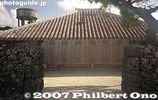
Okinawan house, Taketomi. Taketomi is a National Important Traditional Townscape Preservation District (重要伝統的建造物群保存地区).
|
|
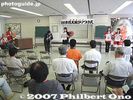
July 7, 2007: The making of the giant kite started with Noritsuke Pasting Ceremony where the new design was announced and dignitaries pasted together the first pieces of the kite paper.
|
|
|

Entrance to Itoh Chube'e Memorial House
|
|

Ohmi Railways Gokasho Station, waiting room.
|
|

Former home of Omi merchant Tonomura Shigeru (外村 繁邸). MapTonomura Shigeru (外村 繁), Tonomura Uhee (外村 宇兵衛), and Nakae Jungoro (中江 準五郎)
|
|
|

Raising a pole in front of Inazawa Station
|
|
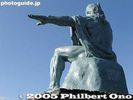
The left leg is poised for action to assist humanity.
|
|
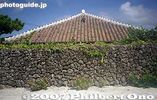
Okinawan house and rock wall, Taketomi
|
|

Clothing worn by Hino merchants
|
|

Front garden
|
|

Ohmi Railways Gokasho Station building as seen from the train platform.
|
|

Entrance to former home of Omi merchant Tonomura Shigeru (外村 繁邸). Gokasho is also a National Important Traditional Townscape Preservation District (重要伝統的建造物群保存地区).
|
|

Takashimaya got its name from Takashima, Shiga Prefecture.
|
|

Before announcing the final kite design, they announced the three best (but not winning) design entries. The public was invited to submit kite designs based on the theme of "Life" or inochi.
|
|

Raising a pole in front of Inazawa Station
|
|
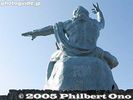
Rear view
|
|

Lookout tower
|
|

Travel passport required to travel around Japan
|
|

Front garden
|
|

Ohmi Railways Gokasho Station train platform.
|
|

Entrance to former home of Omi merchant Tonomura Shigeru.
|
|

1st floor of Takashimaya Dept. Store.
|
|

Twenty-six design entries were submitted this year. There was no top winner, so the final design was based on the three best designs. This design features the kanji "Yorokobu" or joyfulness. 今回のテーマは「いのち」
|
|
|
|

Peace Statue description
|
|

On Taketomi, residential homes are toward the middle of the island, not along the beaches. The middle part of the island is built on hard rock called chert. Freshwater wells can be dug along this rock to provide water. View from lookout tower.
|
|

Sake containers
|
|

Maid's room
|
|

In front of Gokasho Station is a map and stone monument. Gokasho is also a National Important Traditional Townscape Preservation District (重要伝統的建造物群保存地区).
|
|

Living room of former home of Omi merchant Tonomura Shigeru.
|
|

Exhibit of Nagahama bonsai plum trees and folding screen from Hikone, 1st floor of Takashimaya Dept. Store during the Grand Omi Fair.
|
|

They introduced the three best designs. 最優秀作品はなく、3点の優秀賞作品を参考に保存会が決めた。
|
|

They zig-zag along the street, and they are filled with sake.
|
|

Monument next to Peace Statue
|
|
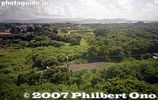
Outside the middle part of Taketomi, the ground is on limestone where water seeps through. Difficult to have rice paddies or wells on limestone.
|
|
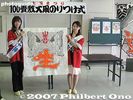
The new kite design was then announced. Called Han-jimon (判じもん), the design expresses a certain theme using word play with a pair of animals and one or two kanji characters. 八日市大凧は3年に一度図柄を変える。
|
|

Medicine
|
|

Inside entrance. The house was occupied by Itochu company founder Itoh Chube'e and his son, Chube'e II.
|
|

Stone monument for the local Obata shonin merchants.
|
|
|
|
|
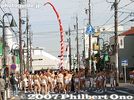
Every once in a while, they raise their pole.
|
|
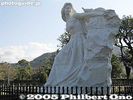
Peace memorial from ChinaThe park also has peace monuments from various countries.
|
|
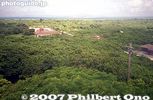
View from lookout tower
|
|

The top kanji is "yorokobu" (joyfulness) which can also be read as "ki." The pair of hawks 鷹 can be read as "yo." And the bottom kanji is "sei" (living). It's "Kyosei."
|
|

Shopkeeper's desk
|
|

Road in front of the train station.
|
|
|
|

Folding screen from Hikone (National Treasure).
|
|
|

Nagasaki atomic bomb peace park hypocenter
|
|
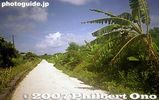
White coral road
|
|

Shopkeeper's desk
|
|

Old Sprite sign
|
|
|

PR exhibit for the Grand Omi Fair on the 8th floor.
|
|

Higashi-Omi mayor Nakamura Koichi explains the design. "Kyosei" 共生 means to co-exist (i.e. man and nature) or to live together harmoniously. 中村功一市長
|
|

On the straight road from Inazawa Station to Konomiya Shrine.
|
|

Peace memorial from Germany
|
|
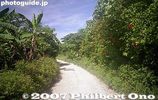
White coral road, one of Taketomi's trademarks.
|
|

Shopkeeper's desk
|
|

Bus stop and sign to the Fujii house. Gokasho has good signs showing you the way to the Omi merchant homes.
|
|

Woman's hairdressing room.
|
|
|
|

The mayor and one of the kite design artists wear a sash and pose for a picture before proceeding with the Noritsuke Ceremony.
|
|
|

Peace memorial from Czechoslovakia
|
|

Hachiman-yama ropeway stationA short walk from Hachiman-bori canal.
|
|

Entrance to Chomeiji Temple. MAP
|
|

Site of Musa-juku's Honjin, the town's exclusive lodging for VIPs to stopover or rest. Only the gate remains.
|
|
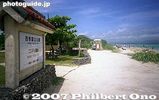
Kondoi Picnic Site
|
|

Shinmachi-dori road with traditional Omi merchant homes. This area is also a National Important Traditional Townscape Preservation District (重要伝統的建造物群保存地区). 近江商人の新町通り MAP
|
|

Okishima (Okinoshima) is Lake Biwa's largest island inhabited by over 400 residents, mainly into fishing. Short boat ride away from Omi-Hachiman's Horikiri port. MAP
|
|

Butsudan Buddhist altar in a butsuma (Buddhist altar room).
|
|
|

Room with Hina festival dolls and entrance to the Tonomura Shigeru Literature Museum. 雛祭りの雛人形
|
|

1st floor of Takashimaya Dept. Store.
|
|

They used a wide brush to apply paste to the edges of a piece of kite paper.
|
|
|

Hypocenter of atomic bomb, adjacent to Peace parkAlmost right next to the Peace park is the hypocenter marker above which the bomb exploded. Often hoards of students on class trips can be see squatting here listening to a talk about this place.
|
|
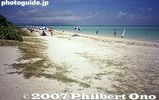
Kondoi beach
|
|

In Omi-Hachiman, Shinmachi-dori looking toward Hachimanyama. This area is also a National Important Traditional Townscape Preservation District (重要伝統的建造物群保存地区).
|
|

Misty Horikiri Port in Omi-Hachiman. Boats leave here for Okishima island, Lake Biwa's largest island.
|
|

Tokonoma alcove and scroll. 奥の間
|
|

Gokasho is a rural town.
|
|

Hina festival dolls. 雛祭りの雛人形
|
|

Grand Omi Fair on 8th floor
|
|

They joined two sheets of kite paper together. This marked the first step in making the kite. The finished kite paper will consist of a few hundred washi paper sheets pasted together.
|
|

Konomiya Shrine torii and the long path to the shrine is lined with a large crowd.
|
|
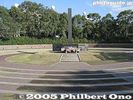
Hypocenter of atomic bombA series of concentric circles emanate from the marker.
|
|
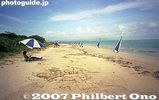
Be aware that these parasols are not free.
|
|
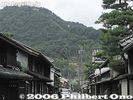
Shinmachi-dori looking toward Hachimanyama
|
|
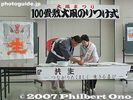
More dignitaries paste the sheets of kite paper together.
|
|

Fishing boats at Horikiri Port
|
|

In 1998, the house was donated to a local foundation. In 2002, the house was opened to the public.
|
|

Another sign.
|
|

Hina festival dolls. 雛祭りの雛人形
|
|

Tourist corner with samurai armor of Hikone's Ii Clan.
|
|

Numerous groups of near-naked men (no women) proceed to the shrine all afternoon.
|
|

Hypocenter markerOn August 9, 1945 an atomic bomb exploded in the sky about 500 meters above the point where this monument now stands. The area within a 2.5 kilometer radius of the hypocenter was completely devastated.
|
|

Kondoi beach
|
|

Boat for Okinoshima at Horikiri Port
|
|

Exhibits of Itoh Chube'e II, the son of the founder Chube'e (1842-1903).
|
|

Entrance to the former residence of Omi merchant Fujii Hikoshiro (1876-1956) (藤井 彦四郎邸)
|
|

Tonomura Shigeru Literature Museum (Bungakukan). Shigeru had a passion for writing, so he entrusted the family business to his younger brother. 外村 繁文学館
|
|
|

The pasted pieces are laid to dry.
|
|
|
|

Hypocenter description
|
|
|
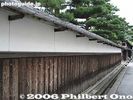
Wall
|
|

Leaving Horikiri Port
|
|

Bust of Itoh Chube'e II (1886-1973), his walking sticks, bag, and shoes.
|
|

Former residence of Omi merchant Fujii Hikoshiro (1876-1956) (藤井 彦四郎邸). Now a history museum.
|
|

Picture of Tonomura Shigeru in the Literature Museum (Bungakukan). 外村 繁文学館
|
|

Funa-zushi 鮒寿し
|
|

As the mikoshi depart, there is some entertainment at the Tomioka Hachimangu Shrine.
|
|

We were then invited to sign our names on the kite paper.
|
|

Zig-zag to the shrine
|
|

Remains of Urakami Cathedral wallNext to the hypocenter is this partial cathedral wall.
|
|
|
|
|

Kitchen
|
|

Omi merchant statue.
|
|

Attic
|
|
|

Taiko drummers at Tomioka Hachimangu Shrine.
|
|

The kite design announcement and pasting ceremony lasted an hour, after which a group photo was taken.
|
|
|
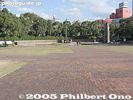
Hypocenter
|
|
|
|

Local Artifacts Museum (Kyodo Shiryokan) 郷土資料館。近江商人・西村太郎右衛門の宅地跡にある資料館
|
|
|
|

Omi merchant statue.
|
|

Hina festival dolls. 雛祭りの雛人形
|
|

Fish and shellfish from Lake Biwa
|
|

Another torii
|
|

Memorial at hypocenterErected in July 1995 for the 50th anniversary.
|
|
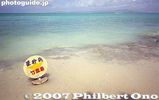
Hoshi Sunahama or Star Sand Beach
|
|
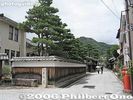
Shinmachi-dori next to Local Artifacts Museum
|
|

Misty Omi-Hachiman coast
|
|

Kitchen
|
|

Bust of Fujii Hikoshiro
|
|

Hina festival dolls. 雛祭りの雛人形
|
|

Ibuki Ham
|
|
|
|

Nagasaki Atomic Bomb Museum. Next to the hypocenter is the atomic bomb museum and registry shelf which stores the names of the atomic bomb victims.
|
|
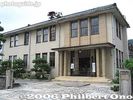
Local Artifacts Museum (Kyodo Shiryokan). Former residence of Omi merchant Nishimura Tarouemon. 郷土資料館
|
|
|
|
|

Stove 炊事場
|
|

Foyer of house 玄関
|
|

Hina festival dolls. 雛祭りの雛人形
|
|

Ibuki Ham
|
|
|

Registry Shelf storing the names of atomic bomb victims
|
|
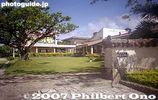
Taketomi Primary School
|
|
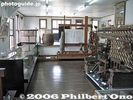
Inside Local Artifacts Museum (Kyodo Shiryokan)
|
|
|
|

Western-style bath from the early 20th century. Very unusual at the time. 西洋風バスルーム
|
|

Entrance room
|
|

2nd floor balcony (Watch your head).
|
|

Vegetable jam
|
|

Romon Gate 楼門
|
|

The Registry Shelf points to the hypocenter.
|
|

Hachiman-yama ropeway takes only 4 min. to go up
|
|
|

Musa's Honjin
|
|
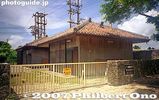
Power voltage station
|
|
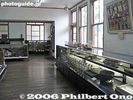
Inside Local Artifacts Museum (Kyodo Shiryokan)
|
|

Okinoshima in sight
|
|

Bathroom sink
|
|

Omi merchant display
|
|

2nd floor balcony
|
|

Omi beef, each pack here cost over 2,000 yen. 近江牛
|
|

July 8, 2007: On the day after the pasting ceremony, the Kamitsugi or paper joining was next. 紙継ぎ
|
|

After passing through this gate, the men enter the shrine grounds. Romon Gate 楼門
|
|

Nagasaki Atomic Bomb Museum entrance
|
|
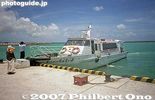
Taketomi Port boat for Ishigaki
|
|
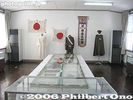
Connected to the Local Artifacts Museum is the History and Folklore Museum (Rekishi Minzoku Shiryokan) 歴史民族資料館
|
|

Misty Okinoshima
|
|

Built in 1935, a memorial for Itoh Chube'e in Kurenai Park. くれない園
|
|

Corridor to rooms and garden.
|
|

View from 2nd floor balcony
|
|
|
|

Starting at 9:30 am, members of the giant kite preservation society began pasting and joining about 400 sheets of washi paper to make the giant kite paper.
|
|

Haiden Hall where the men offer their long poles. 拝殿
|
|

Soldier's uniform, History and Folklore Museum
|
|

Entering Okinoshima Port. Okishima is the largest island in Lake Biwa. MAP
|
|

Memorial marking Itoh Chobe'e's house, right near Itoh Chube'e's house. Chobe'e was Chube'e's older brother and co-founder of Marubeni Corporation.
|
|

2nd floor with more Hina dolls.
|
|

Stamp of Approval from Shiga
|
|

The top two rows of washi sheets already pasted together.
|
|

Haiden Hall 拝殿
|
|

History and Folklore Museum
|
|
|

Another guest meeting room 客間
|
|

2nd floor room with Hina festival dolls. 雛祭りの雛人形
|
|

Mochi making
|
|

The size of the room almost exactly matches the size of the giant kite which is 12 meters by 13 meters or 100 tatami mats.
|
|

Now empty, this path will soon be filled with thousands of men in loincloths.
|
|

Soldier's send-off flag, History and Folklore Museum
|
|

Side of boat
|
|

Main guest room 主客間
|
|

2nd floor room looking toward the balcony.
|
|

Mochi
|
|

The paper is Mino Washi, from Gifu Prefecture. It is white, and surprisingly thin. I thought it would be thicker. Six or so sheets are stacked while slightly spread apart.
|
|

Some of the men tear off strips from their handband and give them to bystanders.
|
|
| 4000 files on 16 page(s) |
1 |
 |
 |
 |
 |
|